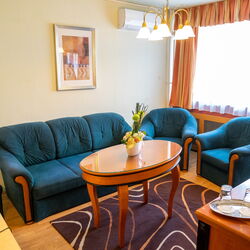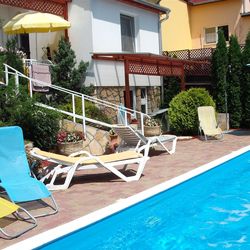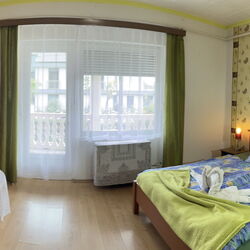Beef specialties from Csáford
Berkovics-Tarsoly Lídia has combined family heritage with accounting precision to build her small-scale operation, where every meat product reflects genuine care and expertise. There are no additives, no shortcuts—only natural ingredients, time, and attention. Thanks to their nature-friendly livestock farming, Lídia creates products that are flavorful on their own. A visit to their farm introduces you to a family who treats their animals with deep respect. Come and taste their authentic flavors!
Back to the roots
Lídia grew up immersed in farming life. Her father raised cattle and processed meat, so slaughtering, feeding, and all aspects of animal husbandry were part of her everyday world. Spending time alongside her father, she learned first-hand what it means to raise animals responsibly, process meat, and create quality food.
Although she studied accounting and initially worked in that field, she soon found her way back to farming. What started as a hobby—raising cattle for family use—soon grew into a business. Today, she runs her own farm, guided by the knowledge passed down from her father.
Respect for animals shows in product quality
At Lídrind Porta, animals live in free-range conditions, grazing along the banks of the Zala River. Their well-being directly impacts the quality of the meat. The family also grows their own feed, ensuring complete control over what goes into their products.
Their goal: to raise healthy, well-cared-for animals that provide high-quality meat for their handcrafted products. Butchering, cutting, curing, and smoking are all done by hand at their small-scale facility in Csáford.
Natural beef specialties
LídRind Porta's signature products include smoked beef ham, sausage, and salami. They have also expanded into pork products and offer fresh farm eggs.
A recent specialty is their basturma—a spiced, air-dried beef rolled in an aromatic herb crust. Served with sourdough bread and homemade cheese, it’s a true delicacy.
Lídia follows a natural approach not only in animal husbandry but also in meat processing. Preservation is done simply with salt, deliberately avoiding nitrites, artificial colors, and fast-curing methods. Smoking is carried out with acacia and beech wood.
Hams are cured slowly, developing their distinct flavors and textures naturally—unlike industrial products where shortcuts are the norm. Seasonings are made from natural ingredients, often home-grown, such as paprika for their spicy salami and juniper berries for unique flavor profiles.
Farm-to-table on the Csáford Vineyard
At Lídrind Porta, you’re not only welcome to buy their products—you can taste them right on the farm. Their countryside dining experience includes generous cold platters, hearty hot dishes, and homemade desserts, like traditional Zala-style pork fat pastries.
The heart of their hospitality lies in sharing good food and memorable experiences. A visit to Lídrind Porta offers more than a meal; it’s an invitation into the world of small-scale farming, meat processing, and artisanal production. Visits are by appointment, so be sure to book ahead by phone.
Product highlights
Smoked beef ham & sausage
LídRind Porta’s beef sausage and smoked ham are crafted for those who appreciate traditional flavors and pure ingredients. Made from free-range, home-raised cattle, the sausages are seasoned with classic spices—paprika, garlic, pepper, and salt—without any artificial additives. They are hand-stuffed into natural casings and smoked over beech and acacia wood.
The smoked beef ham undergoes a long, cold-smoking process and is preserved using only natural salt. Cuts such as thigh, shoulder, and neck are cured individually for optimal flavor and texture. Slow curing and gentle smoking give LídRind Porta products their distinct character. No preservatives, colorants, or fast-cure methods are used.
Where to Find LídRind Porta:
- 8795 Zalaszentgrót, W3G9+37
- Google Maps
More information & Contact:
- Phone: +36 30 792 2968
Did you know the Zala River once flowed into the Drava and only later “found” Lake Balaton? What sets the Quaternary Period (2.58 million years ago to the present) apart from earlier geological epochs is that the surface-shaping processes of this time — and the landforms they produced — continue to define our geographic environment today. One of the most pivotal surface processes during the Pleistocene (2.58 to 0.01 million years ago) was the migration of riverbeds and the formation of terraces and alluvial fans. These changes were closely tied to the slow retreat of the Pannonian Lake, which once filled much of the Carpathian Basin (see also: The Legacy of the Ancient Pannonian Lake). The early Danube initially flowed westward across what is now western Hungary, draining into the retreating Pannonian Lake. This westward course likely remained until the early Pleistocene. The most dramatic hydrological change in the Carpathian Basin occurred between the Pliocene and Pleistocene: the formation of the Danube’s Visegrád Gorge (today’s Danube Bend), which diverted the river toward the center of the country and what is now the Pest Plain. This shift profoundly affected all its former western tributaries — including the Zala. The river system of Central Transdanubia evolved in surprising ways, and the Zala’s journey is one of its most remarkable chapters. The Rába River already flowed northeastward toward the Little Hungarian Plain. The ancient Marcal, running northward, flowed into the Rába — and into it, in turn, flowed the ancient Zala. But nature redrew the map — using the Zala as its brush. A now-vanished river flowing from north to south (its remnants visible today between Zalaszentgrót and Zalavár) cut into the landscape through a process called headward erosion — where rivers erode backward into the terrain, much like a hot knife slicing through butter. Eventually, it cut into the ancient Zala’s valley and “captured” the river, diverting it into its own course. From then on, the Zala made a sharp turn south at Türje and — with no Lake Balaton yet in existence — initially emptied into the Drava. Later, as the depression that would one day become Lake Balaton deepened, the Zala was gradually drawn toward it. Lake Balaton, as a continuous body of water, is only about 5,000 years old — but for millions of years before, the Zala had already been on a winding journey that ultimately made it Balaton’s primary source of water, and the most life-giving river in the region today.
The history of western Hungary’s water systems is not just a fascinating geological puzzle — it reads like an epic of Earth history: riverbeds shift, rivers “consume” one another, and even Lake Balaton doesn’t enter the scene until the final chapter. Discover how nature reshaped this landscape stroke by stroke — and how the Zala became Balaton’s most vital source of water.The Quaternary Period and the Power of Landscape Formation
Pleistocene Changes: Riverbed Migrations and Terraces
The Ancient Danube Moves West
A River’s Great Turning Point
The Story of the Zala: Migration and Capture
A New Path — and the Birth of Lake Balaton















